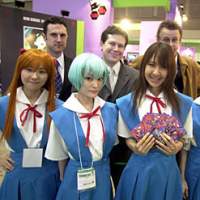If there's one thing that's drawing the eyes of the world toward Japan, it'sanime. From "Akira" to "Spirited Away," through years of moving, high-concept beauties and "video nasties," and right down to the plethora of sprawling half-hour cartoon series, animation is widely regarded as Japan's key artistic export. Influencing Hollywood movies such as "The Matrix," earning Oscars and attracting tourists, its role in international understanding of Japanese culture is undeniable.
This year's Tokyo International Anime Fair (TAF), the sixth, will play host to more than 260 exhibitors as it continues to provide an annual meeting place for anime companies, buyers and fans. Running from next Thursday at Tokyo Big Sight, the fair offers two business days and two public days, with special events, awards, screenings and other attractions in abundance.
"Last year we had 99,984 visitors over four days," chief producer Hitoshi Suzuki tells The Japan Times via e-mail. "This year, we hope to beat 100,000!"
As love for anime spreads across the globe, TAF plays an important role. Founded in 2002 by a coalition of anime companies and local government as a way to increase the art form's international potential, the fair is now a major date on the industry calendar.
"Having this convention in Japan is important as it not only shows how committed the industry is but also emphasizes the government's support," says Kaoru Mfaume, managing director of Manga Entertainment Ltd. Set up in England in 1991, Manga was one of the first exporters of Japanese animated features. The company has cofunded such movies as "Ghost in the Shell," which inspired Hollywood blockbuster "The Matrix," and distributes countless features and series throughout Europe and the United States.
"Most of my time at TAF will be spent speaking to existing Manga licensors, as well as looking for new product," Mfaume says. "I enjoy looking out for new talent too."
The fair begins with two business days -- not open to the public -- and then switching to two public days when anyone can attend, the fair is almost two events in one.
"The atmosphere in the venue changes completely after the business days," says Suzuki. "For the business days, we aim to create the best environment for exhibitors and buyers. For the public days, where people of all ages gather, we create an amusement space that is easy for anime fans and family visitors to navigate. We work hard to satisfy both types of visitor."
As with previous events, the first day of this year's TAF will feature the Tokyo Anime Awards, where anime creators jostle for a 1 million yen main prize. Entries include many from overseas.
Indeed, foreign animation plays a big part of the fair. TAF's press department says that this year roughly 20 percent of exhibitors are from overseas, with France, Italy, Australia, Canada, the United States, China, Thailand, South Korea and Taiwan represented.
"There are so many wonderful anime studios and anime festivals in Japan and overseas," says Suzuki. "If the anime industries around the world improve together through friendly rivalry in technique, originality and commerciality, that will help the growth of the whole worldwide industry."
So what can you expect to see at this year's Tokyo International Anime Fair? Well, you'll certainly see some anime, as the fair houses a theater, and a market selling DVDs and collectibles will run every day. Also look out for special guests such as voice actors Koichi Yamadera ("Ghost in the Shell," "Neon Genesis Evangelion") and Minami Takayama ("Detective Conan," "Ki-ki's Delivery Service"), voice workshops, conferences, exhibitions from young talent, a robot-animation exhibition, a first peek at the latest anime-inspired video games and tons more. Saturday also features live performances of anime songs by soundtrack artists such as Isao Sasaki, Akira Kushida and Psychic Lover from 6.30 p.m., while the business days play host to industry press conferences and symposiums.
While some exhibitors' stalls will doubtless feature men and women dressed as that company's key mascots, one thing you won't see at TAF is "cosplayers." These fans who dress elaborately as their favorite characters are synonymous with anime, but organizers cite a lack of dressing-room space and a professional business atmosphere as reason enough to ban cosplayers from parading at TAF. So leave your Doraemon outfit at home, or you won't get in.
Mfaume says that while he does find the event fun, he will be there mainly on business. His top tips for 2007's hot properties are "Devil May Cry," "Redline" and "Appleseed," "but I also enjoy finding the diamonds in the rough in the independent booths."
Aside from looking for anime to license for export, Mfaume will be checking up on new advances in the field. "I will most certainly be looking at exhibitors who have interesting ideas in terms of production techniques," he says. "With where we are in the digital age, it is crucial to be a few steps ahead in understanding the technological aspects of the business, as it will invariably affect the way we present product to the consumer."
And what of the consumer? Will attendees at TAF's public days find themselves surrounded by an endless cast of drooling anime otaku, die-hard obsessives for all things animated? Or will it be a family day out populated by regular Joes? Probably a bit of both.
Mfaume says: "I'd like to think it attracts a wider demographic but sadly, in Japan, I think the punters are likely going to be more otaku than not."
"The main visitors for the public days are anime fans and families," asserts Suzuki. "Pre-elementary school children and over-65s get free entry, so we attract a wide demographic. We also attract many foreigners living in Japan and anime fans who come all the way from their countries on tours just to attend TAF."
Geeks or not, attendees at this year's TAF will find plenty to amuse them -- and the international anime industry will grow just that little bit stronger.





















With your current subscription plan you can comment on stories. However, before writing your first comment, please create a display name in the Profile section of your subscriber account page.